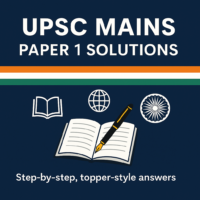Weekly Current Affairs (5-6 October 2024)
Centre Rejects USCIRF’s Report on Religious Freedom in India
1. Why in News?
- On October 3, 2024, India’s Ministry of External Affairs (MEA) rejected the United States Commission on International Religious Freedom’s (USCIRF) report, calling the organization biased and politically motivated.
2. Key Points from the Indian Government’s Response:
- Bias and Political Agenda: MEA spokesperson Randhir Jaiswal labeled the USCIRF as a biased organization with a political agenda, accusing it of misrepresenting facts and promoting a harmful narrative about India.
- Rejection of the Report: India rejected the 2024 annual report by USCIRF, which suggested that the US designate India as a “Country of Particular Concern” due to religious freedom violations.
- Advice to USCIRF: The MEA advised USCIRF to focus on human rights issues within the United States rather than targeting India.
3. Overview of the USCIRF Report:
- Religious Freedom Violations: The USCIRF report claimed that religious freedom in India worsened throughout 2024, particularly around the national elections. It mentioned incidents of violence against religious minorities.
- Legislative Changes: The report highlighted India’s anti-conversion and anti-terrorism laws, implementation of the 2019 Citizenship Amendment Act (CAA), and Uttarakhand’s Uniform Civil Code (UCC) bill as examples of discriminatory legislation.
- Expropriation of Worship Places: It raised concerns about the demolition and expropriation of mosques for other purposes, which it claimed violated India’s Places of Worship Act.
- Targeting Minorities: The report detailed incidents of religious minority targeting, including the arrest of Christians for alleged forced conversions and the exploitation of anti-cow slaughter laws to target Muslims, Christians, and Dalits.
4. Criticisms Against Indian Government Actions:
- Violence After Ayodhya Temple Consecration: The report noted violence following the consecration of the Ayodhya temple in January 2024, with attacks on religious minorities, particularly Muslims, in multiple states.
- Political Hate Speech: It also flagged discriminatory rhetoric used by political officials, including Prime Minister Modi, against Muslims before the June 2024 Lok Sabha elections.
- Civil Society Crackdown: USCIRF accused Indian authorities of using the Foreign Contribution Regulation Act (FCRA) to obstruct the work of civil society and faith-based organizations, with multiple Christian NGOs losing their licenses.
MCQs:
1. What was the key criticism made by India’s Ministry of External Affairs (MEA) regarding the USCIRF report on religious freedom?
- A) It praised India’s religious freedom policies.
- B) It misrepresented facts and had a political agenda.
- C) It ignored human rights issues in the US.
- D) It called for the removal of the Indian Prime Minister.
2. According to the USCIRF report, what law was cited as discriminatory in the context of India’s religious freedom violations?
- A) Citizenship Amendment Act (CAA)
- B) National Security Act
- C) Indian Penal Code
- D) Consumer Protection Act
OCI (Overseas Citizen of India) Card Rules
1. No Recent Changes to OCI Rules
- Despite complaints by OCI cardholders being reclassified as “foreigners,” the Ministry of External Affairs clarified that no recent changes were made to the OCI rules.
- The 2021 Gazette notification remains in force, with no new amendments introduced recently.
2. What is an OCI Card?
- Introduced in August 2005, the OCI scheme registers Persons of Indian Origin (PIOs) who were citizens of India after January 26, 1950, or eligible to become citizens.
- OCI cardholders are foreign passport holders who receive a multiple-entry, lifelong visa for visiting India without the need for registration with the local police.
3. Privileges of OCI Cardholders
- OCI cardholders have general parity with NRIs in terms of economic, financial, and educational fields, except in acquiring agricultural or plantation properties.
- As of 2023, there were over 45 lakh registered OCI cardholders from 129 countries, with the US, UK, Australia, and Canada topping the list.
4. Key Amendments in 2021
- OCI cardholders need a permit to visit protected areas in India, such as Jammu & Kashmir and Arunachal Pradesh.
- They require special permits to undertake research, missionary, journalistic activities, or to visit protected/restricted areas.
- OCI cardholders are treated on par with foreign nationals in financial, economic, and educational fields under FEMA, 2003, altering their earlier parity with NRIs.
5. Previous Changes to OCI Rules
- 2005-2009 Amendments introduced lifelong visas, exemption from FRRO registration, and parity with NRIs in areas like inter-country adoption, domestic airfare, and entry fees at historical sites and wildlife sanctuaries.
- The amendments also allowed parity with NRIs for professions such as doctors, advocates, and architects, as well as appearing in Indian competitive exams.
6. Who Cannot Be an OCI Cardholder?
- OCI cards are not available to those whose parents or grandparents were citizens of Pakistan or Bangladesh.
- Foreign military personnel (both active and retired) are also ineligible.
- However, spouses of Indian citizens or OCI cardholders (with a marriage subsisting for at least two years) can apply for OCI.
TOPICBihar Floods
1. Bihar’s Annual Flood Crisis
- Flood Prone State: Bihar is one of India’s most flood-prone states, with 76% of the population in North Bihar affected by recurring floods each year.
- 2023 Impact: Over 11.84 lakh people displaced, suffering from loss of crops, livestock, and exposure to water-borne diseases.
2. Geographical Reasons for Floods
- River Systems: Bihar is crisscrossed by snow-fed and rain-fed rivers, such as Kosi, Gandak, and Bagmati, which overflow during heavy rains.
- Sediment Accumulation: Rivers from the Himalayas carry loose soil and sediments, leading to frequent overflowing during heavy rainfall.
- Permanent Waterlogging: Factors like silted rivers, drainage issues, embankment-induced waterlogging, and saucer-shaped depressions (“Chaurs”) contribute to waterlogging during monsoons.
3. Classification of Floods
- The Bihar Disaster Management Authority categorizes floods into:
- Flash Floods (due to rainfall in Nepal)
- River Floods (slow receding)
- Drainage Congestion
- Permanent Waterlogging
4. Embankments and Kosi River
- Kosi – ‘Sorrow of Bihar’: Known for frequent floods, embankments were built along the Kosi in the 1950s to contain it.
- Problems with Embankments: The embankments have narrowed the river, causing the riverbed to rise, increasing flood risks.
- Recent Floods: The Birpur barrage in Nepal released 6.6 lakh cusecs of water, causing severe flooding in Bihar, with embankments breached at several places.
5. Economic and Social Impact
- Floods lead to significant economic losses, including damage to crops, infrastructure, loss of livestock, and migration.
- The state spends about Rs 1,000 crore annually on flood management and relief efforts.
6. Proposed Solutions
- Dam Proposal: Building a dam on the Kosi has been proposed, but it requires cooperation from Nepal.
- Additional Barrages: Proposals for new barrages at Supaul, Areraj, and Bagmati are under consideration.
- Non-Structural Solutions: Experts suggest focusing on flood risk reduction, warnings, training, and mitigation rather than just structural solutions like embankments.
7. Rethinking Flood Management
- Flood Atlas of Bihar suggests that minimizing risk and damage is more effective than relying solely on structural measures in a dynamic river system like Kosi.
What is the primary cause of flash floods in Bihar?
- a) Heavy rainfall within the state
- b) Excessive irrigation
- c) Rainfall in Nepal and sediment-filled rivers
- d) Melting of Himalayan glaciers
Answer: c) Rainfall in Nepal and sediment-filled rivers
Explanation: Flash floods in Bihar are primarily caused by rainfall in Nepal, which leads to the overflow of Himalayan rivers, filled with sediments, into Bihar
Why do embankments along the Kosi River fail to control floods?
- a) They were never completed
- b) The riverbed has risen due to sediment buildup
- c) They are not tall enough
- d) They were built in the wrong locations
Answer: b) The riverbed has risen due to sediment buildup
Explanation: Embankments on the Kosi River have failed because they trapped sediment within a narrower path, causing the riverbed to rise by about 5 inches a year, making it prone to overflow
Israel’s Multi-Layered Air Defence System
1. Iron Dome – The Short-Range Shield
- Purpose: Short-range ground-to-air defense system designed to neutralize rockets, artillery, and mortars fired from short distances, such as those from Hamas.
- Deployment: Developed post-2006 Israeli-Lebanon war and deployed in 2011.
- Success Rate: Known for its high success rate in intercepting incoming threats at short distances.
- Fun Fact: It’s not just a defense system—it’s like a superhero shield, saving lives by intercepting rockets mid-air with precision!
2. David’s Sling – The Middleman Defender
- Purpose: Intercepts medium-range missiles, designed for missiles traveling 100 to 200 km.
- Development: Jointly developed by Rafael (Israel) and RTX Corp (US), operational since 2017.
- Hit-to-Kill Technology: Uses the Stunner missile with no warhead—destroys threats through force of impact, making it incredibly precise and advanced.
- Fun Fact: David’s Sling is like the middle sibling of the air defense family—swift, sharp, and always ready to handle the bigger problems before they escalate!
3. Arrow 2 & Arrow 3 – The Outer Space Guardians
- Purpose: These systems protect against long-range missiles that fly outside the Earth’s atmosphere.
- Capabilities: Effective against Tactical Ballistic Missiles (TBMs), including those carrying weapons of mass destruction.
- Technology: Developed by Israel Aerospace Industries (IAI), capable of destroying incoming threats with impressive accuracy.
- Unique Fact: The Arrow system is like a space-age guardian—watching over the skies and ensuring that even high-flying threats don’t stand a chance.
4. Iron Beam – The Laser Show
- Purpose: Designed for short-range rockets (up to 10 km), using laser beams to destroy targets.
- Cost-Effective: Cheaper than traditional interceptors with almost zero cost per interception.
- Unlimited Magazine: It can fire multiple times without running out of ammunition—a “light-speed” response system.
- Fun Fact: Think of Iron Beam as Star Wars meets reality—a laser system capable of vaporizing rockets in the blink of an eye!
5. The Strategic Role of Israel’s Multi-Layered Defense
- Versatility: Each system is layered to handle specific ranges—from short to long-distance missile threats—ensuring Israel is covered at every level.
- Success in 2024: During the October 2024 conflict with Iran, multiple systems—beyond just Iron Dome—worked together to intercept a significant number of missiles.
- Funny Observation: With David’s Sling, Iron Dome, and Iron Beam, it feels like Israel’s defense systems are gearing up for the ultimate Avengers team-up!
Unique Insights:
- Why “Iron Dome” Isn’t Alone: Although Iron Dome gets the fame, it’s part of a well-oiled machine that involves multiple systems working in harmony.
- Laser Fun: The Iron Beam not only looks futuristic but is cheaper and more environmentally friendly, avoiding the need for explosive interceptors.
- Real-World Impact: Israel’s defense system is highly effective, but it also leads to minimal collateral damage, which is crucial in densely populated areas.
Disciplining Judges in India
Why in News?
- The Supreme Court expressed concerns over a Karnataka High Court judge’s remarks.
- The issue highlights the challenges of disciplining judges in India, given constitutional protections.
Challenges of Disciplining Judges in India
- Constitutional Protection:
- Article 121: Prevents parliamentary discussions on judges’ conduct except for impeachment.
- Article 211: Prohibits state legislatures from discussing judges’ conduct.
- Difficult Impeachment Process:
- Article 124(4): Requires impeachment motion to be passed by two-thirds majority in each House.
- History: No Supreme Court judge has been impeached despite impeachment proceedings being triggered five times.
- Narrow Definition of Misbehaviour:
- Grounds for removal are limited to proved misbehaviour or incapacity.
- Misconduct like indiscipline or bias does not meet impeachment standards.
Procedure of Removal of Judges
- Process Overview:
- A judge can be removed by the President after Parliament presents an address for removal based on a special majority.
- Impeachment Motion:
- Requires 100 members in Lok Sabha or 50 members in Rajya Sabha to sign the motion.
- Investigated by a three-member committee consisting of a Supreme Court judge, a High Court judge, and a distinguished jurist.
- Final Steps:
- If the committee finds the judge guilty, the motion is considered by Parliament, followed by Presidential removal.
Other Disciplinary Provisions
- Judicial Intervention:
- The SC can take direct judicial action, e.g., Justice C.S. Karnan was sentenced to imprisonment for contempt in 2017.
- Transfer Policy:
- The Collegium can transfer judges, sometimes as a disciplinary measure, e.g., Justice P.D. Dinakaran was transferred during impeachment proceedings.
- In-House Inquiry:
- A three-member committee can investigate judges under the in-house procedure, introduced in 1999.
- Censure and Resignation:
- Judges may be advised to resign or retire, failing which, judicial work may be withheld from them.
- Code of Judicial Ethics:
- The Restatement of Values of Judicial Life (1997) serves as a code of conduct for maintaining judicial discipline.
Global Perspectives on Judicial Discipline
- Lithuania:
- Judicial discipline is handled by the Judicial Ethics and Discipline Commission and Judicial Court of Honour.
- Germany:
- States have special tribunals for judicial supervision, including at the federal level.
- Scotland:
- The Lord President nominates an investigator for judicial discipline.
- International Frameworks:
- Bangalore Principles of Judicial Conduct (2002) and UN Basic Principles on the Independence of the Judiciary (1985) aim to maintain judicial integrity.
Measures to Ensure Judicial Discipline
- National Judicial Council (NJC):
- The proposed Judges (Inquiry) Bill, 2006 aimed to establish the NJC for oversight.
- Judicial Oversight Committee:
- The Judicial Standards and Accountability Bill, 2010 sought to create oversight mechanisms like the Complaints Scrutiny Panel.
- Clear Conduct Standards:
- A Code of Conduct for judges can outline ethical expectations and address violations.
- Judicial Performance Evaluation:
- Judicial performance can be evaluated through criteria such as case disposal rates and adherence to ethical standards.
- Asset Declaration:
- Judges could be required to declare assets and liabilities to deter corruption.
- Training Programs:
- Regular workshops on judicial ethics and anti-discrimination laws can foster accountability.
- Safeguarding Judicial Independence:
- Reforms must protect judicial independence while ensuring accountability.
MCQs
- Which article of the Indian Constitution prohibits parliamentary discussion on the conduct of Supreme Court or High Court judges except for the purpose of impeachment?
- a) Article 121
- b) Article 211
- c) Article 124(4)
- d) Article 312
Answer: a) Article 121
Explanation: Article 121 prevents parliamentary discussion on the conduct of judges except in cases of impeachment, ensuring judicial independence.
- What is the minimum number of members required in the Lok Sabha to sign a motion for the impeachment of a judge?
- a) 50
- b) 100
- c) 75
- d) 60
Answer: b) 100
Explanation: The Judges Enquiry Act, 1968 requires a minimum of 100 Lok Sabha members to sign the impeachment motion for it to be considered by the Speaker.
Impact of West Asia Conflict on Trade and India
Escalation of Conflict
Recent Escalation: The conflict between Israel and Iran has intensified, with Israel launching operations against Hezbollah in Lebanon. This has raised concerns about prolonged trade disruptions.
Hezbollah’s Role: Hezbollah, an Iranian proxy, is now a target of Israel’s military, which has expanded the conflict. This has increased the likelihood of disruptions along the vital Red Sea shipping route, a key artery for global and Indian trade.
Impact on Global and Indian Trade
Red Sea Route Crisis: Traders are concerned about the long-term closure of the Red Sea shipping route, which could increase freight rates and hinder trade.
Indian Export Decline: India’s exports, especially petroleum products, saw a sharp decline due to the Red Sea crisis. In August 2024, petroleum exports fell by 38%, contributing to an overall 9% export decline.
Shipping Costs and Route Diversions: Due to the closure of the Red Sea, ships have taken longer routes around the Horn of Africa, increasing shipping costs by 15-20%. This has affected Indian exporters’ margins, particularly in low-value sectors like textiles and garments.
Silver Linings for India
Neutrality of GCC Countries: Countries like Saudi Arabia, UAE, and Qatar remain neutral, which has allowed India’s trade with them to grow. India’s exports to Iran also saw a 15.2% rise.
Possible Relief: The situation could improve if Israel successfully neutralizes the Houthi rebels, who have been disrupting Red Sea shipping.
Global Shipping and Indian Exporters’ Response
Increased Shipping Costs: Global shipping firms, such as Maersk, have reported higher profits due to rising freight rates. Indian exporters are advocating for the development of a national shipping line to reduce dependency on foreign companies.
Potential Drop in Shipping Rates: If the disruptions in the Red Sea are resolved, shipping rates may decrease due to an oversupply of container ships ordered during the pandemic.
Impact on India-Middle East-Europe Economic Corridor (IMEC)
Threat to IMEC: The West Asia conflict could delay the development of the India-Middle East-Europe Economic Corridor, an alternative route aimed at reducing dependence on the Suez Canal.














